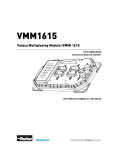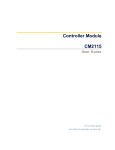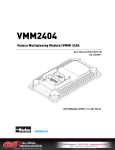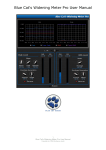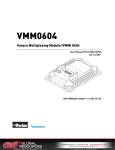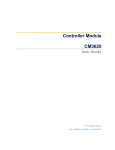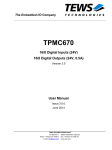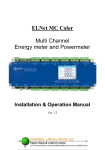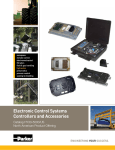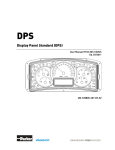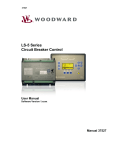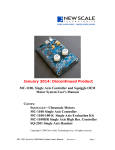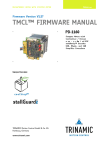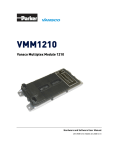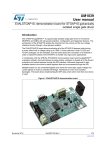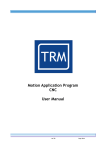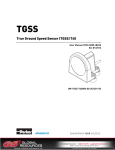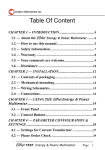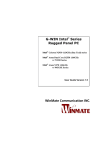Download Vansco User Guide
Transcript
Vansco Multiplexing Module VMM1615 User Guide HY33-5008-IB/US UG-VMM1615-154200-201309-003 Parker Hannifin Corporation Electronic Controls Division 1305 Clarence Avenue Winnipeg, MB R3T 1T4 Canada office +1 204 452 6776 Fax +1 204 478 1749 http://www.parker.com/ecd Copyright 2013 © Parker Hannifin Corporation. All rights reserved. No part of this work may be reproduced, published, or distributed in any form or by any means (electronically, mechanically, photocopying, recording, or otherwise), or stored in a database retrieval system, without the prior written permission of Parker Hannifin Corporation in each instance. Warning! FAILURE OR IMPROPER SELECTION OR IMPROPER USE OF THE PRODUCTS AND/OR SYSTEMS DESCRIBED HEREIN OR RELATED ITEMS CAN CAUSE DEATH, PERSONAL INJURY AND PROPERTY DAMAGE. This document and other information from Parker Hannifin Corporation, its subsidiaries and authorized distributors provide product and/or system options for further investigation by users having technical expertise. The user, through its own analysis and testing, is solely responsible for making the final selection of the system and components and assuring that all performance, endurance, maintenance, safety and warning requirements of the application are met. The user must analyze all aspects of the application, follow applicable industry standards, and follow the information concerning the product in the current product catalog and in any other materials provided from Parker or its subsidiaries or authorized distributors. To the extent that Parker or its subsidiaries or authorized distributors provide component or system options based upon data or specifications provided by the user, the user is responsible for determining that such data and specifications are suitable and sufficient for all applications and reasonably foreseeable uses of the components or systems. Offer of Sale The items described in this document are hereby offered for sale by Parker Hannifin Corporation, its subsidiaries or its authorized distributors. This offer and its acceptance are governed by the provisions stated in the "offer of Sale" elsewhere in this document, or available at www.parker.com. Contents Publication History ............................................................................................................. vii Safety .................................................................................................................................... ix Safety symbols .................................................................................................................................ix General safety regulations ...............................................................................................................ix Welding after installation .................................................................................................................. x Construction regulations .................................................................................................................. x Safety during installation .................................................................................................................. x Safety during start-up .......................................................................................................................xi Safety during maintenance and fault diagnosis ...............................................................................xi 1. About the VMM1615 .......................................................................................................... 1 1.1. Diagram conventions ................................................................................................................ 3 2. Quick Start ......................................................................................................................... 5 2.1. Gather Required Materials ........................................................................................................ 5 2.2. Install the Required Software Tools .......................................................................................... 6 2.2.1. Install the Data Link Adaptor Driver Software ............................................................. 6 2.3. Connect the VMM1615 to a Development System ................................................................... 7 2.3.1. Power Up the Development System ........................................................................... 8 2.4. Create and Download Ladder Logic Applications ..................................................................... 9 3. Connectors and Pinouts................................................................................................. 11 3.1. Pinouts .................................................................................................................................... 14 4. Power ............................................................................................................................... 17 4.1. Logic Power ............................................................................................................................ 17 4.1.1. Logic Power Capabilities ........................................................................................... 17 4.2. Busbar Power.......................................................................................................................... 18 4.2.1. Busbar Power Capabilities ........................................................................................ 18 4.3. Sensor supply ......................................................................................................................... 18 4.3.1. Sensor Power Capabilities ........................................................................................ 18 4.3.2. Sensor Power Connections ....................................................................................... 19 5. Inputs ............................................................................................................................... 21 5.1. Digital Inputs ........................................................................................................................... 21 5.1.1. Programmable Digital Inputs ..................................................................................... 21 5.1.2. Power Control Digital Input ........................................................................................ 24 5.1.3. Addressing Digital Inputs ........................................................................................... 26 User Guide iii Contents 5.2. VMM1615 DC-Coupled Frequency Input ................................................................................27 5.2.1. VMM1615 DC-Coupled Frequency Input Capabilities ...............................................28 5.2.2. VMM1615 DC-Coupled Frequency Input Configuration ............................................28 5.3. Analog Inputs ...........................................................................................................................29 5.3.1. Analog Input Capabilities ...........................................................................................29 5.3.2. Analog Input Configurations .......................................................................................31 6. Outputs ............................................................................................................................ 33 6.1. High-Side Outputs ...................................................................................................................33 6.1.1. 10 A High-Side Output Capabilities ...........................................................................34 6.1.2. 5 A High-Side Output with Current Sense Capabilities ..............................................35 6.1.3. 5 A High-Side Output Capabilities .............................................................................38 6.1.4. 2.5 A High-Side Output with Current Sense Capabilities...........................................40 6.1.5. High-Side Output Configuration .................................................................................41 6.1.6. High-Side Output Connections ..................................................................................42 6.2. Low-Side Output with Current Sense ......................................................................................44 6.2.1. Low-Side Output with Current Sense Capabilities .....................................................44 6.2.2. Low-Side Output with Current Sense Configuration ..................................................46 6.2.3. Low-Side Output with Current Sense Installation Connection ...................................47 6.3. Solid State Relays ...................................................................................................................49 6.3.1. Solid State Relay Capabilities ....................................................................................49 6.3.2. Solid State Relay Installation Connections ................................................................50 6.3.3. Solid State Relay Diagnostics ....................................................................................52 7. Communication ............................................................................................................... 53 7.1. Controller area network ...........................................................................................................53 7.1.1. CAN Capabilities ........................................................................................................53 7.1.2. J1939 CAN Configuration ..........................................................................................54 7.1.3. J1939 CAN Installation Connections .........................................................................54 8. VMM1615 Diagnostic LEDs ............................................................................................ 57 9. Installation ....................................................................................................................... 59 9.1. Mechanical Installation Guidelines ..........................................................................................59 9.1.1. VMM1615 Dimensions ...............................................................................................59 9.1.2. Selecting a Mounting Location ...................................................................................59 9.1.3. Environmental Requirements .....................................................................................60 9.1.4. Designing and Connecting the Vehicle Harness .......................................................61 9.1.5. Mounting the VMM1615 .............................................................................................61 9.2. Electrical Installation Guidelines ..............................................................................................62 9.2.1. Connecting the Vehicle Harness to the VMM1615 ....................................................62 9.2.2. Logic and Output Power Connections .......................................................................62 10. Application Examples ................................................................................................... 65 10.1. Implementing Safety Interlocks .............................................................................................65 10.2. Controlling Indicator Lights ....................................................................................................66 10.3. Controlling a Proportional Valve ............................................................................................68 10.4. Controlling Motor Speed ........................................................................................................69 10.5. Using One Analog Input as Two Digital Inputs ......................................................................70 10.6. Sensor Power Connections ...................................................................................................71 iv VMM1615 Contents 10.6.1. Open Collector ......................................................................................................... 72 10.6.2. Connecting a Switch to the VMM1615 .................................................................... 73 10.6.3. Voltage..................................................................................................................... 73 10.6.4. Potentiometer (Ratiometric)..................................................................................... 74 11. Startup............................................................................................................................ 77 12. Glossary ......................................................................................................................... 79 13. Index ............................................................................................................................... 85 User Guide v Publication History The following table provides an overview of the changes made to this document over the course of its publication history. Release Date User Guide Description of Change Rev. 003, September 2013 Update to match Product Specification ver. 02A Minor editorial changes throughout Rev. 002, September 2012 Branding Minor editorial changes throughout Rev. 001 First release of this document vii Safety Do not perform the procedures in this manual unless you are experienced in the handling of electronic equipment. Contact the manufacturer if there is anything you are not sure about or if you have any questions regarding the product and its handling or maintenance. The term "manufacturer" refers to Parker Hannifin Corporation. Safety symbols The following symbols are used in this document to indicate potentially hazardous situations: Danger! Risk of death or injury. Warning! Risk of damage to equipment or degradation of signal When you see these symbols, follow the instructions carefully and proceed with caution. General safety regulations Work on the hydraulics control electronics may only be carried out by trained personnel who are well-acquainted with the control system, the machine, and its safety regulations. Follow the manufacturer's regulations when mounting, modifying, repairing, and maintaining equipment. The manufacturer assumes no responsibility for any accidents caused by incorrectly mounted or incorrectly maintained equipment. The manufacturer assumes no responsibility for the system being incorrectly applied, or the system being programmed in a manner that jeopardizes safety. User Guide ix Safety Do not use the product if electronic modules, cabling, or connectors are damaged or if the control system shows error functions. Electronic control systems in an inappropriate installation and in combination with strong electromagnetic interference fields can, in extreme cases, cause an unintentional change of speed of the output function. Welding after installation Complete as much as possible of the welding work on the chassis before the installation of the system. If welding has to be done afterwards, proceed as follows: Do not place the welding unit cables near the electrical wires of the control system. 1. Disconnect the electrical connections between the system and external equipment. 2. Disconnect the negative cable from the battery. 3. Disconnect the positive cable from the battery. 4. Connect the welder's ground wire as close as possible to the place of the welding. Construction regulations The vehicle must be equipped with an emergency stop which disconnects the supply voltage to the control system's electrical units. The emergency stop must be easily accessible to the operator. If possible, the machine must be built so that the supply voltage to the control system's electrical units is disconnected when the operator leaves the operator’s station. Safety during installation Incorrectly positioned or mounted cabling can be influenced by radio signals, which can interfere with the functions of the system. x VMM1615 Safety Safety during start-up Danger! Risk of death or injury. Do not start the machine's engine before the control system is mounted and its electrical functions have been verified. Do not start the machine if anyone is near the machine. Safety during maintenance and fault diagnosis Before performing any work on the hydraulics control electronics, ensure that The machine cannot start moving. Functions are positioned safely. The machine is turned off. The hydraulic system is relieved from any pressure. Supply voltage to the control electronics is disconnected. User Guide xi 1. About the VMM1615 The VMM1615 is a VMM controller for vehicle and other DC applications with steady state voltages less than 32V. This module is 100% compatible with other Vansco Multiplexing Modules. Figure 1: VMM1615 The VMM1615 has 16 inputs and 15 outputs. Inputs include: programmable gain analog programmable attenuation analog programmable pullup/down digital programmable pullup/down DC coupled frequency type User Guide 1 About the VMM1615 Outputs include: 10 amp high-side 5 amp high-side 2.5 amp high-side 2.5 amp low-side 1 amp solid state relay 2 of the 5 amp and 2 of the 2.5 amp outputs also include accurate current sensing for monitoring loads or for hydraulic control. The VMM1615 has two CAN communication ports for communication with any system module supporting the CAN 2.0B standard. The standard protocol supported is SAE J1939, but others could be supported through custom software development. The VMM1615 follows the controller module road map, which provides hardware that can be used with VMM software (as multiplex modules supporting ladder logic programming). This manual describes the hardware components of the VMM1615, but does not explain how to write or configure the software. For more information about software, refer to the appropriate software manual or contact your Parker Vansco Account Representative. 2 VMM1615 About the VMM1615 1.1. Diagram conventions The following symbols are used in the schematic diagrams in this document: Symbol Meaning General input General output Frequency input Analog input Frequency sensor Pulse sensor Resistive sensor General sensor Application switch Load Pull-down resistor User Guide 3 About the VMM1615 Symbol Meaning Pull-up resistor Battery Fuse Resistor Ground Chassis ground 4 VMM1615 2. Quick Start This section provides step-by-step instructions on how to connect the VMM1615 to a development system, install the required software tools, and download the ladder logic application software. The following is a high-level overview of the steps involved with this section: 1. Gather the required materials. 2. Install the required software tools provided by Parker Vansco. 3. Connect the VMM1615 to a development system (desktop) and power it up. 4. Download the ladder logic application software. 2.1. Gather Required Materials The following materials are required for the procedures in this section: VMM1615 personal computer (PC) controller I/O board controller I/O harness (connects the VMM1615 to the controller I/O board) evaluation kit power harness (connects the controller I/O board to the power supply) User Guide 5 Quick Start Data Link Adapter (DLA) kit (comes with cables needed for connecting the DLA to your PC and to the rest of the system) desktop power supply compatible with the VMM1615 and controller I/O board loads (a 12 V DC, 3 A fixed voltage supply is generally suitable, unless driving more significant loads) procurement drawing for the version of VMM1615 you are using, indicating the configuration options for your variant of the product. software tools and files required for programming and downloading software for the VMM1615. Note: With the exception of the PC and desktop power supply, all materials and software are available from Parker Vansco. Please consult your Parker Vansco Account Representative for specific details and pricing information. 2.2. Install the Required Software Tools Before using the VMM1615, install the following software tools onto your PC: Data Link Adaptor (DLA) drivers The DLA acts as the interface between the PC and the VMM1615. Before using the DLA, you must install the DLA drivers. Parker Vansco Software Tools Parker Vansco provides the VMMS software tool to create and download software for the VMM1615. Contact your Parker Vansco Account Representative, or visit the Parker website to get further information on how obtain a product key. 2.2.1. Install the Data Link Adaptor Driver Software A Data Link Adaptor (DLA) is needed when connecting the VMM1615 in a development system. Note: Parker Vansco provides the latest DLA software releases through its web site. Please contact your Parker Vansco Account Representative for details on how to download the latest DLA driver software. The Parker Vansco DLA requires the installation of drivers on your PC. To install the Parker Vansco DLA drivers: 1. Download the driver, run the extracted file, and follow the Install Wizard. Do not connect the USB DLA until the driver installation is completed. 2. Connect the USB DLA to a USB port on your PC. The Found New Hardware screen opens. 6 VMM1615 Quick Start 3. Select Install the software automatically (Recommended), and then click Next. If the driver is not detected automatically, you can browse to the folder containing the driver (default path C:\Program files\Vansco\USB-DLA). 4. After installation is finished, click Finish. The USB DLA is now recognized and ready to be used. See the Parker Vansco USB DLA kit user manual for more detailed instructions. 2.3. Connect the VMM1615 to a Development System It is a good idea to connect the VMM1615 to a development system (PC, Controller I/O Board, power source, and DLA) to verify your ladder logic application. The development system is an ideal environment for creating and downloading ladder logic software applications. The following shows how to connect the VMM1615 in a development system: Power I/O Board Controller DLA PC Figure 2: Development system connection To connect the VMM1615 in a development system, do the following: Note: Before connecting anything in the development system, ensure that the power supply is set to a voltage that is less than 32 V DC. 1. Connect the Controller I/O harness to the VMM1615 connectors. 2. Connect the Controller I/O harness to the controller I/O board connectors. 3. Connect the evaluation kit power/CAN harness to the controller I/O board’s JP3 connector. User Guide 7 Quick Start 4. Do not connect the power wire (RED) from the evaluation kit power/CAN harness to the power supply (+) terminal at this time. 5. Connect the ground wire (BLACK) from the evaluation kit power/CAN harness to the power supply (-) terminal. 6. Connect the CAN connector from the evaluation kit power/CAN harness to the corresponding mating connector and harness on the DLA. Note: Do not proceed to the next step before the DLA drivers have been installed. See Install the Data Link Adaptor Driver Software on page 6. 7. Connect the DLA to a personal computer via the USB port. 2.3.1. Power Up the Development System To power up the VMM1615: 1. Ensure that all controller I/O board digital inputs, jumpers, and dip switches are properly configured for your module type. Refer to the Controller I/O Board Reference Manual for further details. 2. Ensure that the power wire (RED) on the controller I/O board is not connected to the power supply (refer to the Controller I/O Board Reference Manual for details). 3. Turn the power supply on. 4. If using a variable power supply, set the voltage to a value between 10 to 28 V DC. 5. Turn the power supply off. 6. Connect the power wire (RED) on the connector I/O board to the power supply. 7. Turn the power supply on. Note: If INPUT_1 or INPUT_2 is configured as a power control input, you must turn on the corresponding digital input switch on the controller I/O board (Digital Input 1 or Digital Input 2). Refer to the Controller I/O Board Reference Manual for further details. 8 VMM1615 Quick Start 2.4. Create and Download Ladder Logic Applications Software applications can be created and downloaded to the VMM1615. The software applications for the VMM1615 can be created with the Vansco Multiplexing Module Software (VMMS) tool, using ladder logic. Consult your Parker Vansco Account Representative for information about your software programming options. User Guide 9 3. Connectors and Pinouts The VMM1615 has four 12-pin Deutsch DT connectors: Brown (J1): DT15-12PD Gray (J2): DT15-12PA Green (J3): DT15-12PC Black (J4): DT15-12PB These connectors are used to connect to the inputs, outputs, and communication channels used by the VMM1615. The connectors are keyed to prevent incorrect mating with the vehicle harness. The vehicle harness should be designed to interface with all connectors. To eliminate mis-mating, it is recommended that the harness-side connectors have enhanced keying. The required mating connectors are: Figure 3: Connector J1 User Guide 11 Connectors and Pinouts Figure 4: Connector J2 Figure 5: Connector J3 Figure 6: Connector J4 The maximum wire gauge for the J1, J2, J3, and J4 connectors is 16 AWG with GXL insulation. 12 VMM1615 Connectors and Pinouts The VMM1615 also has two 1-pin Deutsch DTHD connectors for busbar power (power for high-side outputs): Black (J5): DTHD04-1-8P Black (J6): DTHD04-1-8P The required connector is: The maximum wire gauge for the J5 and J6 connectors is 8 AWG with GXL insulation. The following table shows the part numbers for the mating connectors and terminals that are used in the vehicle harness. Mating Connector Part Numbers Connector User Guide Shell part no. Wedge part no. Terminal part no. Brown (J1) connector DT06-12SD-P012 W12S or W12S-P012 16-20AWG, Gold: 1062-16-144 Grey (J2) connector DT06-12SA-P012 W12S or W12S-P012 16-20AWG, Gold: 1062-16-144 Green (J3) connector DT06-12SC-P012 W12S or W12S-P012 16-20AWG, Gold: 1062-16-144 Black (J4) connector DT06-12SB-P012 W12S or W12S-P012 16-20AWG, Gold: 1062-16-144 Black (J5) connector DTHD06-1-8S - 8-10AWG: 0462-203-08141 Black (J6) connector DTHD06-1-8S - 8-10AWG: 0462-203-08141 13 Connectors and Pinouts 3.1. Pinouts Pins connect to inputs, outputs, and communication channels. They provide the interface between the vehicle harness and the internal circuitry of the VMM1615. The following tables show the pinouts for each connector: J1 Connector (Brown) Pinout Pin Name Function 1 OUTPUT1_10A_HS 10 A High-side output 2 GND Ground 3 VBATT_LOGIC Logic power 4 INPUT15_AD Analog or Digital input 5 INPUT7_D Digital input 6 INPUT8_DF Digital or Frequency input 7 OUTPUT14_SSR_A Solid state relay pin A 8 CAN2_HI CAN 2 High 9 CAN2_LO CAN 2 Low 10 CAN1_HI CAN 1 High 11 CAN1_LO CAN 1 Low 12 CAN1_SHLD CAN 1 shield J2 Connector (Gray) Pinout Pin 14 Name Function 1 INPUT4_D Digital input 2 INPUT9_AD Analog or Digital input 3 INPUT10_AD Analog or Digital input 4 INPUT11_AD Analog or Digital input 5 INPUT12_AD Analog or Digital input 6 GND Ground 7 OUTPUT14_SSR_B Solid state relay pin B 8 OUTPUT13_2A5_LS 2.5 A Low-side output 9 OUTPUT15_SSR_B Solid state relay pin B 10 OUTPUT15_SSR_A Solid state relay pin A 11 SENSOR_SUPPLY +5 V or +8 V sensor power 12 OUTPUT2_10A_HS 10 A High-side output VMM1615 Connectors and Pinouts J3 Connector (Green) Pinout Pin Name Function 1 OUTPUT7_5A_HS 5 A High-side output with current sense 2 OUTPUT5_10A_HS 10 A High-side output 3 INPUT1_D Digital input, power control, active high 4 ADDR_5 Address input 5 OUTPUT9_5A_HS 5 A High-side output 6 OUTPUT3_10A_HS 10 A High-side output 7 INPUT2_D Digital input 8 INPUT13_AD Analog or Digital input 9 INPUT14_AD Analog or Digital input 10 INPUT5_D Digital input 11 INPUT6_D Digital input 12 OUTPUT11_2A5_HS 2.5 A High-side output with current sense J4 Connector (Black) Pinout Pin User Guide Name Function 1 OUTPUT12_2A5_HS 2.5 A High-side output with current sense 2 GND Ground 3 ADDR1 Address input 4 ADDR2 Address input 5 ADDR3 Address input 6 ADDR4 Address input 7 OUTPUT4_10A_HS 10 A High-side output 8 OUTPUT10_5A_HS 5 A High-side output 9 INPUT16_AD Analog or Digital input 10 INPUT3_D Digital input 11 OUTPUT6_10A_HS 10 A High-side output 12 OUTPUT8_5A_HS 5 A High-side output with current sense 15 4. Power The VMM1615 is powered by the vehicle battery. The VMM1615 operates in a 12 V or 24 V system, and can operate from 6 V up to 32 V, with overvoltage protection at 36 V. The various pins on the connectors are used for different types of power, as detailed in the following sections. 4.1. Logic Power The VMM1615 has one pin, labeled VBATT_LOGIC, dedicated to providing power for logic circuitry, and three pins, labeled GROUND, dedicated to grounding the VMM1615. 4.1.1. Logic Power Capabilities Logic power provides power to the logic circuit, which consists of the microprocessor, RAM, etc. While this input can be connected to any voltage within the specified voltage range, it is required that the voltage be greater than or equal to the maximum voltage present on either of the busbar inputs, and the bias for any low side or solid state relay outputs. Failure to do so may damage the module. The following table provides specifications for the VMM1615 logic power: Logic Power Specifications Item User Guide MIN NOM MAX Input voltage range 6 - 32 V UNIT Overvoltage - - 36 V Current, operating mode @ 6V - - 700 mA Current, operating mode @ 32V - - 180 mA Current, sleep mode @ 32V - 0.3 1 mA Recommended inline fuse - - 10 A Recommended inline circuit breaker - - 6 A 17 Power 4.2. Busbar Power There are two main power connections for the high current bus bar battery power inputs (BUSBAR1 and BUSBAR2). The busbar inputs are separated into two connectors (J1 and J2). 4.2.1. Busbar Power Capabilities Busbar power provides power to the output circuits through a battery or ground connection. Each busbar circuit can draw a maximum of 40 A. The following table provides specifications for the VMM1615 busbar power: Busbar Power Specifications Item MIN NOM MAX UNIT Number of busbars - 2 - Busbar voltage range 6 - 32 V Overvoltage (5 minutes) - - 36 V Busbar current (per connector) - - 40 A Inline fuse required on busbar pins - - 50 A 4.3. Sensor supply The VMM1615 has one pin, labeled SENSOR_SUPPLY, dedicated to providing power to external sensor. Warning! Do not drive more than 300 mA of current through the SENSOR_SUPPLY pin. Doing so will cause the pin to protect itself by dropping the voltage, which will result in a lack of power to the sensors, causing unknown vehicle responses. 4.3.1. Sensor Power Capabilities The SENSOR_SUPPLY offers two software programmable output voltages of either 5 V or 8 V. It is a switching regulator that supplies a high output current that does not have to be derated when used on 24V systems. Note: The voltage provided to the VMM1615 must be 7 V or greater to ensure that the SENSOR_SUPPLY can provide 5 V. The voltage provided to the product must be 10 V or greater to ensure the sensor supply can provide 8 V. 18 VMM1615 Power The following table provides specifications for the VMM1615's sensor power output: Sensor Power Specifications Item MIN NOM MAX Input voltage range (5 V output) 7 - 32 Input voltage range (8 V output) 10 - 32 V - - 36 V Output voltage range (5 V) 4.74 5.02 5.30 V Output voltage range (8 V) Overvoltage UNIT 7.63 8.09 8.56 V Output voltage accuracy - - 6 % Output current 0 - 300 mA 4.3.1.1. Sensor Power Fault Responses SENSOR_SUPPLY is designed to survive short-to-battery, short-to-ground, and overcurrent events. If these events occur, the circuit will recover as described in the following table: Sensor Power Fault Recovery Event Recovery Short-to-battery (sensor voltage = battery voltage) Sensor voltage recovers when the short is removed. Short-to-ground (sensor voltage = ground) Sensor voltage recovers when the short is removed. Overcurrent (sensor voltage = ground) Sensor voltage recovers when the overcurrent condition is removed. 4.3.2. Sensor Power Connections For information on how to connect sensors, refer to Application Examples on page 65. User Guide 19 5. Inputs The VMM1615 has digital, frequency, and analog inputs. Damage to equipment! Do not connect inputs directly to unprotected inductive loads such as solenoids or relay coils, as these can produce high voltage spikes that may damage the VMM1615. If an inductive load must be connected to an input, use a protective diode or transorb. 5.1. Digital Inputs Digital inputs are typically used with electrical signals and switches that are either on or off. There are three types of digital inputs in the VMM1615: Programmable Digital Inputs Power Control Digital Inputs Addressing Digital Inputs 5.1.1. Programmable Digital Inputs The VMM1615 has 5 programmable digital inputs: INPUT3_D through INPUT7_D. 5.1.1.1. Programmable Digital Input Capabilities The following table provides specifications for the VMM1615's programmable digital inputs: User Guide 21 Inputs Programmable Digital Input Specifications MIN NOM MAX Input voltage range Item 0 - 32 V Overvoltage - - 36 V Inductive load protection - Yes - - Pull-up/down resistance 713 750 788 Ω Capacitance at pin - 0.005 - µF Pull-up/down frequency - - 40 Hz Pull-up/down duty cycle - - 12 % Pull-up/down active time 3 - - ms Negative going input threshold - - 1.56 Positive going input threshold 3.82 - - V Input Frequency @ 50% duty - - 20 Hz 263 - - Ω - - 1.32 kΩ Active Low - Activating Resistance @ 6V Active Low - Deactivating Resistance @ 6V Active Low - Activating Resistance @ 32V Active Low - Deactivating Resistance @ 32V Active High - Activating Resistance @ 6V Active High - Deactivating Resistance @ 6V Active High - Activating Resistance @ 32V Active High - Deactivating Resistance @ 32V Active High - Activating Resistance @ 6V Active High - Deactivating Resistance @ 6V UNIT V 39 - - Ω - - 102 Ω 427 - - Ω - - 2.1 kΩ 5.5 - - kΩ - - 14.6 kΩ 2.4 - - kΩ - - 6.9 kΩ 5.1.1.2. Programmable Digital Input Configuration Digital inputs are configured as active high or active low by using pull-up or pulldown resistors internal to the module. A digital switch (typically connected to a digital input) usually requires wetting current to burn off contact oxidation when it is activated. The amount of required wetting current required is based on battery voltage and on the value of the pulldown resistor. Wetting current is determined by the value of the resistor. The maximum wetting current in the VMM1615 is 10 mA at 7.5 V DC. 22 VMM1615 Inputs 5.1.1.3. Programmable Digital Input Installation Connections A digital input is typically connected to a switch that is either open or closed. When the switch is open, the pull-up or pull-down resistor will ensure that no signal exists on the input pin, which will be interpreted by the VMM1615 as inactive. When the switch is closed, the input is connected to either battery voltage or ground, which will be interpreted by the VMM1615 as active. Active-high input The active-high output must be connected to battery power to ensure that there is a battery connection when the state of the input changes. The following shows a typical active-high digital input connection: Internal to product Application Switch Active High Digital Input Battery Figure 7: Active high digital input Active low input The active-low input must be connected to ground to ensure there is a ground connection when the state of the input changes. User Guide 23 Inputs The following shows a typical active-low digital input connection: Internal to product Application switch Active Low Digital Input Figure 8: Active low digital input connections 5.1.2. Power Control Digital Input The VMM1615 has 1 active-high power control digital input that is used for waking up (turning on) the product, as follows: INPUT1_D There is a second non-power control digital input with the same active-high characteristics. It is not used to wake-up the product. INPUT2_D 5.1.2.1. Power Control Input Capabilities The VMM1615 has 1 active high digital input. INPUT1_D is used for power control. This input has a pull down resistor only. The power control input requires an active high signal to be detected by the microprocessor, as well as to power up the module. 24 VMM1615 Inputs The following table provides specifications for the VMM1615's power control digital input: Power Control Digital Input Specifications Item MIN NOM MAX UNIT Input voltage range 0 - 32 V Overvoltage - - 36 V Inductive load protection - Yes - - 1.9 2.0 2.1 kΩ Capacitance at pin - 0.01 - µF Negative going input threshold - - 1.56 V Positive going input threshold 3.82 - - V Input Power Up Threshold 1.4 - 3.9 V - 98 - Hz Pull-down resistance Cutoff frequency (hardware) Note: The power control digital input voltage must be greater than 3.9 V before it is considered an active high input. The power control digital input wakes up the VMM1615 when switched high to a voltage of 3.9 V or greater, and turns the VMM1615 off when switched low to a voltage less than 1.4 V. The VMM1615 also shuts off when an open circuit condition occurs on the power control digital input. 5.1.2.2. Power Control Digital Input Installation Connections You must be aware of the following when connecting power control inputs: The power control digital input is usually connected to the vehicle ignition, but it can be connected to any power source in a system. When battery power (VBATT_LOGIC) is connected, and the power control digital input is inactive, the VMM1615 will go into sleep mode. User Guide 25 Inputs The following diagram shows a typical power control digital input connection: Internal to product Application Switch Power Control Input Power Control Pull-Down Resistor Battery Figure 9: Power control digital input installation connections 5.1.3. Addressing Digital Inputs Digital inputs ADDR1, ADDR2, ADDR3, ADDR4 and ADDR5 are dedicated address inputs. These inputs are used to set the system address on the module such that it is unique among all other modules in the system. The maximum allowable addresses in a VMM system is 31 including all devices on the bus (VMMs, PGM, LIMs, etc.). These inputs are all active-low inputs with internal pull-up resistors. The inputs are read when the module starts to indicate which portion of ladder logic the module is to run. The state of these inputs must be valid before turning the VMM on. It is recommended that these inputs be permanently grounded (depending on desired address) in the vehicle harness to ensure a valid state before power up. The addressing arrangement is shown in the following table, which shows the required inputs that need to be active and floating (active shown as 1, floating shown as 0). 26 VMM1615 Inputs VMM System Address Inputs 5 4 3 2 1 VMM Address 0 0 0 0 0 VMM1 0 0 0 0 1 VMM2 0 0 0 1 0 VMM3 0 0 0 1 1 VMM4 0 0 1 0 0 VMM5 1 1 1 1 0 VMM31 Note: Address 32 is reserved and may not be used. The following shows a typical addressing digital input connection. Internal to product Customer connection Addressing Digital Input Figure 10: Addressing digital input connections 5.2. VMM1615 DC-Coupled Frequency Input There is one type of frequency input in the VMM1615: DC-coupled frequency input The input detects frequency signals that are pre-conditioned to fall within the DC threshold ranges of the input. Unlike an AC-coupled input, this input is used with frequency sensors that switch between system ground and sensor/battery power. Typical sensor types are Hall Effect. The VMM1615 has one DC-coupled frequency input: INPUT8_DF User Guide 27 Inputs 5.2.1. VMM1615 DC-Coupled Frequency Input Capabilities A DC-coupled frequency input allows you to read the frequency of external signals that switch between system ground, and sensor or battery power. This input is ideal for use with hall-effect type sensors. The following table provides specifications for the VMM1615's DC-coupled frequency input: DC-Coupled Frequency Input Specifications Item MIN NOM MAX 0 - 32 V 5.31 5.36 5.41 kΩ Capacitance at pin - .005 Overvoltage - - 36 V Frequency accuracy - - 5 % Frequency range 1 - 10000 Hz Negative going threshold - - 1.56 V Positive going threshold 3.82 - - V Input voltage range Pull-up/pull-down resistance UNIT µF 5.2.2. VMM1615 DC-Coupled Frequency Input Configuration The DC-coupled frequency input can be configured to use a pull-up resistor, pulldown resistor or neither. The following diagram shows the configuration for the DC-coupled frequency input: Internal to product Application sensor Filter + - Pull-up/down option Figure 11: DC-coupled frequency input configuration 28 VMM1615 Inputs 5.3. Analog Inputs Analog inputs are typically used to read electrical signals that span a voltage range. The VMM1615 has 8 analog inputs: INPUT9_AD through INPUT16_AD Two of the analog inputs (INPUT9_AD and INPUT10_AD) are type 1, amplified, and the remaining analog inputs (INPUT11_AD through INPUT16_AD) are type 2, attenuated. Analog inputs can also be configured to function as programmable digital inputs. 5.3.1. Analog Input Capabilities Type 1 analog inputs have programmable gain and are driven through an amplifier to provide a wider array of input range options. These inputs have programmable pull-up or pull-down resistor values, including a resistor that can be used for 4 to 20mA sensor readings. The following provides specifications for the VMM1615's type 1 analog inputs: Type 1 Analog Input Specifications Item MIN MAX UNIT Input voltage range 0 - 32 V Overvoltage - - 36 V Inductive load protection - No - - Pull-up voltage V VLOGIC 0.7 Pull-up resistance 3.29k 3.33k 3.36k Ω Pull-down resistance 1 3.29k 3.33k 3.36k Ω Pull-down resistance 2 246 249 252 Ω Capacitance at pin - 0.005 - µF 74.9 - - KΩ Resolution - - 11.25 Bit Frequency cutoff - 23 - Hz Input resistance with pull-up/down inactive User Guide NOM 29 Inputs Type 1 Analog Input Voltage Ranges GAIN Max Volts ATN1 ATN2 GAIN1 GAIN2 5.005 0.599 OFF OFF ON ON 4.005 0.749 OFF OFF OFF ON 2.000 1.500 OFF OFF ON OFF 1.000 3.000 OFF OFF OFF OFF 0.962 3.119 ON OFF ON ON 0.770 3.898 ON OFF OFF ON 0.739 4.058 OFF ON ON ON 0.592 5.072 OFF ON OFF ON 0.456 6.578 ON ON ON ON 0.384 7.806 ON OFF ON OFF 0.365 8.220 ON ON OFF ON 0.295 10.157 OFF ON ON OFF 0.192 15.611 ON OFF OFF OFF 0.182 16.462 ON ON ON OFF 0.148 20.314 OFF ON OFF OFF 0.091 32.925 ON ON OFF OFF Type 2 analog inputs have programmable attenuation and are driven directly into the module analog to digital converter (ADC). These inputs have programmable pull-up or pull-down resistor values, including a resistor that can be used for 4 to 20mA sensor readings. The following provides specifications for the VMM1615's Type 2 analog inputs: Type 2 Analog Input Specifications Item MIN NOM MAX Input voltage range 0 - 32 V Overvoltage - - 36 V Inductive load protection - No - - Pull-up resistance 3.29k 3.33k 3.36k Ω Pull-down resistance 1 3.29k 3.33k 3.36k Ω Pull-down resistance 2 246 249 252 Ω - 0.005 - µF 74.9k - - Ω Resolution - - 11.25 Bit Accuracy - 3 Frequency cutoff - - Capacitance at pin Input resistance with pull-up/down inactive 30 UNIT % 23 Hz VMM1615 Inputs Type 2 Analog Input Ranges - INPUT 15 GAIN Max Volts ATN1 ATN2 1.000 3.000 OFF OFF 0.192 15.611 ON OFF 0.148 20.314 OFF ON 0.091 32.925 ON ON Type 2 Analog Input Ranges - INPUT 11-14, 16 GAIN Max Volts ATN1 ATN2 1.000 3.000 OFF OFF 0.542 5.535 ON OFF 0.223 13.423 OFF ON 0.188 15.958 ON ON 5.3.2. Analog Input Configurations The analog inputs have the ability using VMMS software to have either a pull-up or pull-down resistor enabled, have pull-up and pull-down enabled at same time, have a separate pull-down (of 249 ohms) enabled for 4 to 20 mA current sensor, or no pull-up or pull-down resistors at all. User Guide 31 Inputs With Type 1 analog inputs (INPUT9_AD and INPUT10_AD) Select the input voltage range in your ladder logic application, which automatically sets the attenuation and gain The following diagram shows the configuration for Type 1 analog inputs: Internal to product Application sensor Pull-up value Filter + - Pull-down value 249 ohm Attenuation Gain Pull-up / pull-down options Figure 12: Type 1 analog input configuration options With Type 2 analog inputs (INPUT11_AD through INPUT16_AD) Select the input voltage range in your ladder logic application, which automatically sets the amount of attenuation. The following diagram shows the configuration for Type 2 analog inputs: Internal to product Application sensor Pull-up value Filter + - Pull-down value 249 ohm Attenuation Pull-up / pull-down options Figure 13: Type 2 analog input configuration options 32 VMM1615 6. Outputs The VMM1615 has 15 solid-state outputs. Output currents can range from 1.0 to 10.0 Amps. The VMM1615 has 4 types of outputs: High-side outputs High-side outputs with current sense Low-side outputs Solid state relay outputs A high-side and a low-side output can be coupled in the external harness to create a half-bridge. 6.1. High-Side Outputs The controller has a total of 12 high-side outputs. High-side outputs are used for switching voltage to loads using either a pulsewidth modulated (PWM) signal, or an on/off signal. They can also test for various fault conditions, which can be used for software diagnostics (refer to High-Side Output Diagnostics and Fault Detection for more details). 6 outputs are rated for 10 A: OUTPUT1_10A_HS to OUTPUT6_10A_HS 2 of the outputs are rated for 5 A with current sensing: OUTPUT7_5A_HS to OUTPUT8_5A_HS 2 of the outputs are rated for 5 A: OUTPUT9_5A to OUTPUT10_5A 2 of the outputs are rated for 2.5 A with current sensing: OUTPUT11_2A5_HS to OUTPUT12_2A5_HS User Guide 33 Outputs 6.1.1. 10 A High-Side Output Capabilities These outputs provide 10 A maximum continuous current with a less accurate current sensing function. The current sensing is used to detect overcurrent and provide short circuit protection. The following table provides specifications for the VMM1615's 10 A high-side outputs: 10 A High-Side Output Specifications Item MIN NOM MAX UNIT Switchable voltage range 6 - 32 V Output current 0 - 10 A Output on state resistance - 9 - Overvoltage - - 36 V PWM frequency - - 500 Hz PWM resolution - 0.1 - % Integrated flyback diode - No - - Inductive pulse protection - - 628 V (peak) Digital feedback negative going threshold - - 2.58 V mΩ Digital feedback positive going threshold 2.75 - - V Open load detection resistance 3.29 3.32 3.35 kΩ - 77 - Current sense resolution/bit - 15.9 - Current sense accuracy @ 10 A - - 30 % Leakage current when off - - 51 uA Current sense gain mV/A mA Fixed Output Protection The outputs have the following fixed protection mechanisms: 34 VMM1615 Outputs Software fuse – The software samples the measured current at a predefined rate and compares this value to a set of current ranges. In these ranges multipliers are specified which either increment or decrement the fuse value by a multiplier. If the fuse value reaches the trip point, the output is shut off. The fuse value cannot be decremented below the minimum fuse value. This mechanism is disabled in the event of a hard short circuit Software short circuit – The output has software short circuit detection. If the output is PWM’d, the digital feedback is sampled at each falling edge. If the output is simply turned on, the digital feedback is sampled at the set frequency. 10 A High-Side Output Software Short Circuit Specifications Item MIN NOM MAX Digital feedback negative going threshold - - 2.58 V Digital feedback positive going threshold 2.75 - - V 1 - 5000 Hz Sample rate UNIT Over temperature – If the temperature of the driver IC reaches the thermal trip point, the output is disabled. The output will be re-enabled when the driver cools down to an acceptable level. 6.1.2. 5 A High-Side Output with Current Sense Capabilities These outputs provide 5 A maximum continuous current with accurate current sensing. The current sensing provides accurate readings to detect single load disconnect on parallel driven load applications (i.e. when multiple loads are driven by a single output). User Guide 35 Outputs The following table provides specifications for the VMM1615's 5 A high-side outputs: 5 A High-Side Output with Current Sense Specifications Item MIN NOM MAX UNIT Switchable voltage range 6 - 32 V Output current 0 - 5 A Output on state resistance - 20 - mΩ Overvoltage - - 36 PWM frequency - - 500 Hz PWM resolution - 0.1 - % Integrated flyback diode - No - - Inductive pulse protection - - 628 V (peak) Digital feedback negative going threshold - - 2.69 V Digital feedback positive going threshold 2.86 - - V Open load detection resistance 9.9k 10k 10.1k Ω mΩ Current Sense resistance V 24.75 25 25.25 Current Sense gain - 275 - Current Sense resolution - - 4.4 Current Sense accuracy - Full Scale (5 A) - 3 - % Leakage current when off - - 15 uA mV/A mA Fixed Output Protection The outputs have the following fixed protection mechanisms: 36 VMM1615 Outputs Software fuse – The software samples the measured current at a predefined rate and compares this value to a set of current ranges. In these ranges multipliers are specified which either increment or decrement the fuse value by a multiplier. If the fuse value reaches the trip point, the output is shut off. The fuse value cannot be decremented below the minimum fuse value. This mechanism is disabled in the event of a hard short circuit Software short circuit – The output has software short circuit detection. If the output is PWM’d, the digital feedback is sampled at each falling edge. If the output is simply turned on, the digital feedback is sampled at the set frequency. 5 A High-Side Output w/CS Software Short Circuit Specifications Item MIN NOM MAX Digital feedback negative going threshold - - 2.69 V Digital feedback positive going threshold 2.86 - - V 1 - 5000 Hz Sample rate UNIT Over temperature – If the temperature of the driver IC reaches the thermal trip point, the output is disabled. The output will be re-enabled when the driver cools down to an acceptable level. Hardware overcurrent protection – The output has hardware overcurrent protection which will disable the output when a potentially damaging overcurrent situation is detected. The tripping threshold of the circuit is a function of both current and time. The figure shows the envelope of inrush current that the circuit is designed to permit. An inrush profile with currents outside of this envelope is not guaranteed to pass through without tripping the hardware overcurrent circuit. Figure 14: High side output - 5A current sense inrush envelope User Guide 37 Outputs 6.1.3. 5 A High-Side Output Capabilities These outputs provide 5 A maximum continuous current with a less accurate current sensing function. The current sensing is used to detect overcurrent and provide short circuit protection. The following table provides specifications for the VMM1615's 5 A high-side outputs: 5 A High-Side Output Specifications Item MIN NOM MAX Switchable voltage range 6 - 32 V Output current 0 - 5 A Output on state resistance - 20 - mΩ Overvoltage - - 36 V PWM frequency - - 500 Hz PWM resolution - 0.1 - % Integrated flyback diode - No - - Inductive pulse protection - - 628 V (peak) Digital feedback negative going threshold - - 2.69 V Digital feedback positive going threshold 2.86 - - V Open load detection resistance kΩ 9.9 10 10.1 Current Sense gain - 111 - Current Sense resolution - - 11.0 UNIT mV/A mA Current Sense accuracy @ 5A - - 25 % Leakage current when off - - 15 uA Fixed Output Protection The outputs have the following fixed protection mechanisms: 38 VMM1615 Outputs Software fuse – The software samples the measured current at a predefined rate and compares this value to a set of current ranges. In these ranges multipliers are specified which either increment or decrement the fuse value by a multiplier. If the fuse value reaches the trip point, the output is shut off. The fuse value cannot be decremented below the minimum fuse value. This mechanism is disabled in the event of a hard short circuit Software short circuit – The output has software short circuit detection. If the output is PWM’d, the digital feedback is sampled at each falling edge. If the output is simply turned on, the digital feedback is sampled at the set frequency. 5 A High-Side Output Software Short Circuit Specifications Item MIN NOM MAX Digital feedback negative going threshold - - 2.69 V Digital feedback positive going threshold 2.86 - - V 1 - 5000 Hz Sample rate UNIT Over temperature – If the temperature of the driver IC reaches the thermal trip point, the output is disabled. The output will be re-enabled when the driver cools down to an acceptable level. Hardware overcurrent protection – The output has hardware overcurrent protection which will disable the output when a potentially damaging overcurrent situation is detected. The tripping threshold of the circuit is a function of both current and time. The figure shows the envelope of inrush current that the circuit is designed to permit. An inrush profile with currents outside of this envelope is not guaranteed to pass through without tripping the hardware overcurrent circuit. Figure 15: High Side Output - 5A Inrush envelope User Guide 39 Outputs 6.1.4. 2.5 A High-Side Output with Current Sense Capabilities These outputs provide 2.5 A maximum continuous current with accurate current sensing. The current sensing provides accurate readings to detect single load disconnect on parallel driven load applications (i.e. when multiple loads are driven by a single output). The current sensing can also be used for regulating current control of hydraulic coils. The following table provides specifications for the VMM1615's 2.5 A high-side outputs: 2.5 A High-Side Output with Current Sense Specifications MIN NOM MAX Switchable voltage range Item 6 - 32 V Output current 0 - 2.5 A Output on state resistance - 45 - Overvoltage - - 36 V PWM frequency - - 500 Hz PWM resolution - 0.1 - % Integrated flyback diode - Yes - Inductive pulse protection - - 628 V (peak) Digital feedback negative going threshold - - 2.63 V Digital feedback positive going threshold 2.80 - - V Open load detection resistance 9.9k 10k 10.1k Ω 24.75 25 25.25 mΩ Current Sense gain - 503 - Current Sense resolution - - 2.4 Current Sense accuracy - Full Scale (2.5 A) - 3 - % Leakage current - - 16 uA Current Sense resistance UNIT mΩ - mV/A mA Fixed Output Protection The outputs have the following fixed protection mechanisms: 40 VMM1615 Outputs Software fuse – The software samples the measured current at a predefined rate and compares this value to a set of current ranges. In these ranges multipliers are specified which either increment or decrement the fuse value by a multiplier. If the fuse value reaches the trip point, the output is shut off. The fuse value cannot be decremented below the minimum fuse value. This mechanism is disabled in the event of a hard short circuit Software short circuit – The output has software short circuit detection. If the output is PWM’d, the digital feedback is sampled at each falling edge. If the output is simply turned on, the digital feedback is sampled at the set frequency. 2.5 A High-Side Output w/CS Software Short Circuit Specifications Item MIN NOM MAX Digital feedback negative going threshold - - 2.63 V Digital feedback positive going threshold 2.80 - - V 1 - 5000 Hz Sample rate UNIT Over temperature – If the temperature of the driver IC reaches the thermal trip point, the output is disabled. The output will be re-enabled when the driver cools down to an acceptable level. 6.1.5. High-Side Output Configuration For software-controlled open load detection, the programmer has the ability to choose when to bias the output through the open load detection resistor. This feature may be disabled by the programmer using VMMS software if the output is connected to sensitive loads, such as LEDs. User Guide 41 Outputs The following diagram shows the configuration for high-side outputs: Internal to product High-Side Driver Battery voltage Strobed Open Load Detect Application Load Figure 16: High side output configuration 6.1.6. High-Side Output Connections When connecting high-side outputs, note that: High-side outputs are connected to one of two internal bus bars, which can be connected to a +12 V or +24 V battery. Each busbar powers 3x 10 A, 2x 5 A, and 1x 2.5 A outputs. Maximum load on each busbar is 40 A. High-side outputs can provide switched battery power to a variety of load types in a vehicle. 2.5 A high-side outputs have internal flyback diodes, which are needed when driving inductive loads (the flyback diodes absorb electrical energy when the load is turned off). Note: If large inductive loads are used, and the high-side output is providing a continuous PWM signal, the PWM peak current must not be greater than the specified continuous current for the output (in continuous mode, the average current flow through the diode at 50% duty cycle is approximately equal to one half of the peak current). 42 VMM1615 Outputs When connecting high-side outputs, follow these best practices: Do not connect high-side outputs to loads that will draw currents greater than the maximum peak current or maximum continuous current. Connect the load grounds in close physical proximity to the power grounds. The following shows a typical high-side 10 A or 5 A output connection: Internal to product High-Side Output Application Load Figure 17: High-side output installation connections The following shows a typical high-side 2.5 A output connection with integrated flyback diode: Internal to product High-Side Output Application Load Figure 18: Typical high-side output installation connections User Guide 43 Outputs 6.2. Low-Side Output with Current Sense The low-side output with current sense is used for switching ground to load, using either a pulse-width modulated (PWM) signal or an on/off signal. It also has the ability to sense current that is provided to the load, through an amplifier circuit. The VMM1615 has 1 low-side output: OUTPUT13_2A5_LS The length of the duty cycle is defined in the application software. Note: Current flow is interrupted when using low-side outputs as a PWM signal, because the outputs are not on continuously. Therefore, current feedback control systems should use a high-side output for PWM signals, and a low-side output (turned on at 100%) for sensing current. When low-side outputs are used as an on/off signal, the output provides ground when in the on state (the application software is responsible for switching lowside outputs on and off). When low-side outputs are used to sense current, the application software will monitor the current flowing into the low-side output, and based on the amount of current, will turn the output either on or off. 6.2.1. Low-Side Output with Current Sense Capabilities This output provides 2.5 A maximum continuous current with accurate current sensing. The current sensing provides accurate readings to detect single load disconnect on parallel driven load applications. The current sensing can also be used for current control of hydraulic coils when used with a corresponding highside driver which performs the PWM function. These outputs can be used to provide a fast PWM signal to functions requiring accurate higher speed PWM signal control. 44 VMM1615 Outputs The following table provides specifications for the VMM1615's low-side output: 2.5A Low-Side Output Specifications MIN NOM Switchable voltage range Item 6 - MAX VLOGIC V UNIT Output current 0 - 2.5 A Output on state resistance - 82 - Overvoltage - - 36 Short Circuit Protection - 13 - A Short Circuit Trip Time - - 1 ms PWM frequency - - 1500 Hz PWM resolution - 0.1 - Inductive pulse protection - - 628 V (peak) Current Sense resistance 99 100 101 mΩ Current Sense gain - 1 - V/A Current Sense resolution/bit - - 1.2 mA Current sense accuracy - Full Scale (2.5 A) - 3 - % Leakage current when off - - 10 uA mΩ % Fixed Output Protection The outputs have the following fixed protection mechanisms: User Guide 45 Outputs Software fuse – The software samples the measured current at a predefined rate and compares this value to a set of current ranges. In these ranges multipliers are specified which either increment or decrement the fuse value by a multiplier. If the fuse value reaches the trip point, the output is shut off. The fuse value cannot be decremented below the minimum fuse value. This mechanism is disabled in the event of a hard short circuit Hardware overcurrent protection – The output has hardware overcurrent protection which will disable the output when a potentially damaging overcurrent situation is detected. The tripping threshold of the circuit is a function of both current and time. The figure shows the envelope of inrush current that the circuit is designed to permit. An inrush profile with currents outside of this envelope is not guaranteed to pass through without tripping the hardware overcurrent circuit. Figure 19: Low Side output - 2.5A Inrush envelope 6.2.2. Low-Side Output with Current Sense Configuration The low-side output with current sense is configured as follows: The resistor used for sensing current maximizes the accuracy of the current measurement. 46 VMM1615 Outputs The following diagram shows the configuration options for low-side outputs: Figure 20: Low-side output with current sense configuration 6.2.3. Low-Side Output with Current Sense Installation Connection When connecting a low-side output, note that Low-side outputs are connected to a common internal ground point that is connected to the battery ground (GROUND). Low-side outputs provide switched ground to any load type in a vehicle. Low-side outputs can sink up to 2.5 A. When connecting a load to a low-side output, ensure that the load will not drive currents greater than the maximum specified peak current, or maximum specified continuous current. User Guide 47 Outputs The following shows a typical low-side output connection: Internal to product Low-Side Output Application Load Battery Figure 21: Low-side outputs with current sense installation connections 48 VMM1615 6.3. Solid State Relays The solid state relays are used for switching currents in either direction as an on/off signal. There are two contacts associated with each of this type of output, which act like the two contacts of a normally open mechanical relay. Warning! This circuit is not electrically isolated like a mechanical relay. For proper operation the voltage levels being switched must be between ground and the same voltage that is applied to the Logic Power pin. The VMM1615 has 2 solid state relays: OUTPUT14_SSR_A/OUTPUT14_SSR_B and OUTPUT15_SSR_A/OUTPUT15_SSR_B When solid state relays are used as an on/off signal, the output provides a low impedance path between the "A" and "B" terminals in the on state (the application software is responsible for switching solid state relays on and off). 6.3.1. Solid State Relay Capabilities These outputs support 1.0 A maximum continuous current between their terminals. The following table provides specifications for the VMM1615's solid state relay: Solid State Relay Specifications Item MIN NOM MAX UNIT Switchable voltage range 0 - VLOGIC V Output current 0 - 1 A Output on state resistance - 164 - Overvoltage - - VLOGIC V PWM frequency - - 0 Hz Inductive pulse protection - - 628 Short Circuit Protection - 4 - A Short Circuit Trip time - - 1 ms Leakage current when off - - ±160 uA mΩ V (peak) 6.3.1.1. Fixed Output Protection The outputs have the following fixed protection mechanisms: User Guide 49 Outputs Hardware overcurrent protection – The output will be disabled when a potentially damaging overcurrent situation is detected. The tripping threshold of the circuit is a function of both current and time. The figure shows the envelope of inrush current that the circuit is designed to permit. An inrush profile with currents outside of this envelope is not guaranteed to pass through without tripping the hardware overcurrent circuit. Figure 22: Solid State Relay Output Inrush Capability 6.3.2. Solid State Relay Installation Connections When connecting solid state relays, note that 50 VMM1615 Outputs The solid state relay provides a low impedance path between the “A” and “B” terminal. This circuit is not electrically isolated like a mechanical relay. For proper operation the voltage levels being switched must be between ground and the voltage applied to the Logic Power pin. Solid state relays can support up to 1.0 A. When connecting a load to a solid state relay, ensure the load will not drive currents greater than the maximum specified peak current, or maximum specified continuous current. The following shows typical solid state relay connections: Internal to product A Solid State Relay B Application Load Figure 23: Solid State Relay switching high Internal to product Application Load A Solid State Relay B Figure 24: Solid State Relay switching low User Guide 51 Outputs 6.3.3. Solid State Relay Diagnostics Each solid state relay has the ability to report one type of fault condition. 6.3.3.1. Short Circuit Short circuit faults occur when a solid state relay senses a short from battery to ground across its terminals. The output will turn off and retry as defined by the programmer. 52 VMM1615 7. Communication The VMM1615 uses the Controller Area Network (CAN) communication when communicating with other modules on the vehicle, or with a personal computer. 7.1. Controller area network The VMM1615 hardware provides controller area network (CAN) communication according to the SAE J1939 specification, making the VMM1615 compatible with any CAN-based protocol through software. CAN communication is used to communicate the status of multiple modules that are connected together in the same network. 7.1.1. CAN Capabilities The CAN communicates information at a rate of 250 kbps. Input and output information is communicated through the CAN at a sample rate of 40 Hz. Lack of regular CAN communication is an indication that there is either a problem with a module in the network, or a problem with the CAN bus. These CAN ports offer CAN 2.0B compatible hardware with a Wake on CAN function on CAN1, which is a way to provide power control to the VMM1615. Wake on CAN allows the VMM1615 to come out of sleep mode when any CAN activity is received by the module. If the CAN activity is not continuous, the VMM1615 will return to sleep mode. It is not possible to filter messages that are used to turn on the VMM1615 using Wake on CAN; therefore, any message will turn on the VMM1615. The application software must be written to determine how the VMM1615 will behave when it is turned on. User Guide 53 Communication The following table provides specifications for the CAN. CAN Specifications MIN NOM MAX Overvoltage Item - - 32 Baud rate - 250 - J1939 compliant - Yes - Wake on CAN option - Yes - Onboard termination resistor - No - UNIT V kbps CAN1 7.1.2. J1939 CAN Configuration There are two features associated to CAN communication that are configured: Wake on CAN - the VMM1615 will turn on when a CAN message is received. Internal CAN Termination Resistor - the VMM1615 does not have a 120 Ω CAN termination resistor embedded inside the module, which is required to use CAN communication. You are required to design it into the vehicle harness. Note: Putting CAN termination resistors in the module would violate the J1939 specification, which states that the resistor should be designed into the harness. 7.1.3. J1939 CAN Installation Connections The CAN connection for the VMM1615 should conform to the J1939 standard. For a list of J1939 connection considerations, refer to the SAE J1939 specifications available through the Society for Automotive Engineers. SAE J1939-11 covers the physical aspects of the CAN bus including cable type, connector type, and cable lengths. Note: The VMM1615 does not have a CAN termination resistor, which is based on the assumption that the CAN bus is terminated in the harness. The following lists the elements that are required for a J1939 CAN connection: CAN Cable: A shielded twisted-pair cable should be used when connecting multiple modules to the CAN bus. The cable for the J1939 CAN bus has three wires: CAN High, CAN Low, and CAN Shield (which connect to the corresponding CAN_HIGH, CAN_LOW, and CAN_SHIELD pins on the connector). The CAN cable must have an impedance of 120 Ω. 54 VMM1615 Communication The CAN cable is very susceptible to system noise; therefore, CAN shield must be connected as follows: a. Connect CAN Shield to the point of least electrical noise on the CAN bus. b. Connect CAN Shield as close to the center of the CAN bus as possible. c. Use the lowest impedance connection possible. Note: Ground loops can damage electronic modules. The CAN Shield can only be grounded to one point on the network. If grounded to multiple points, a ground loop may occur. CAN Connectors: Industry-approved CAN connectors are manufactured by ITT Canon and Deutsch, and come in either T or Y configurations. CAN Harness: The CAN harness is the main backbone cable that is used to connect the CAN network. This cable cannot be longer than 40 meters and must have a 120 Ω terminating resistor at each end. The 120 Ω terminating resistors eliminate bus reflections and ensure proper idle-state voltage levels. CAN Stubs: The CAN stubs cannot be longer than 1 meter, and each stub should vary in length to eliminate bus reflections and ensure proper idle state voltage levels. Max Number of Modules in a System: The CAN bus can handle a maximum of 30 modules in a system at one time. The following shows a typical CAN connection using the SAE J1939 standard: T connectors 120 ohm Terminator 120 ohm Terminator Variable length Node Node Variable length Node Node Node Figure 25: J1939 CAN connection User Guide 55 8. VMM1615 Diagnostic LEDs There are 40 available diagnostic LEDs on this module. The LEDs are used to provide diagnostic information for input states, output states, CAN bus activity and module power. Power LED The power LED has three states: on, off, and flashing. off = Sleep Mode on Solid = Module Operating Normally Flashing = Programming Mode (1Hz) Standby LED The standby LED has two states: on or off. There are two conditions that will turn on the standby LED. First, when there is any activity on CAN 1 Network but no power control flags are active. Second, when all power control inputs and power control flags have been removed. If any power control inputs or power control flags are active for the corresponding unit, then the standby LED will be off. NET1 and NET2 LEDs If the NET1 or NET2 LED is flickering, flashing, or on, there is activity on that CAN Bus. If the NET1 or NET2 LED is off, there is no activity on that CAN Bus. Address LEDs An address LED has two states: on or off. If the address pin is active then the corresponding LED for that input will be on. If the address pin is inactive then that LED will be off. Address LEDs do not provide any error/fault detection. User Guide 57 VMM1615 Diagnostic LEDs Input LEDs An input LED has two states, on or off. If the input pin is active then the corresponding LED for that input will be on. If the input pin is inactive then that LED will be off. Input LEDs do not provide any error/fault detection. Output LEDs An output LED has three states: on, off, and flashing. Through software if the output condition is true, then the corresponding LED will be on. If the condition through software is false then that LED will be off. The output LEDs also provide error/fault status. If an output LED is flashing, there is a fault on that output. 58 VMM1615 9. Installation Because every system is different, it is not feasible to provide detailed installation instructions that will be suitable for every assembly. This chapter therefore provides only high-level guidelines on installing the VMM1615. The vehicle manufacturer is responsible for creating procedures for mounting the VMM1615 in a vehicle during production assembly. 9.1. Mechanical Installation Guidelines Use the following guidelines when installing the VMM1615 in a vehicle. 9.1.1. VMM1615 Dimensions The following diagram shows the dimensions of the VMM1615: 247.0 [9.72”] 225.0 [8.86”] 162.0 [6.38”] 140.0 [5.51”] 45.5 [1.79”] Figure 26: VMM1615 dimensions 9.1.2. Selecting a Mounting Location The VMM1615 can be installed in the vehicle's cab or on the chassis. If used in a marine application, ensure that it is protected from excessive salt spray. User Guide 59 Installation Before mounting the VMM1615, review the following environmental and mechanical requirements. Note: Do not install the VMM1615 near any significant heat sources, such as a turbo, exhaust manifold, etc. Avoid installing the VMM1615 near any drivetrain component, such as a transmission or engine block. 9.1.2.1. Mechanical Requirements Review the following mechanical requirements before selecting a mounting location for the VMM1615: The VMM1615 should be mounted vertically so moisture will drain away from it. The wire harness should have drip loops incorporated into the design to divert water away from the VMM1615. The harness should be shielded from harsh impact. The harness should connect easily to the connector and have adequate bend radius. The labels and LEDs should be easy to read. The VMM1615 should be in a location that is easily accessible for service. 9.1.3. Environmental Requirements The VMM1615 warranty does not cover damage caused by exposure of the product to environmental conditions that exceed its design limitations. 1. Mount the VMM1615 in an environment that is within its ambient temperature range of –40 °C to +85 °C. 2. Mount the VMM1615 in an environment that is within its particle ingress rating. The sealing standard for the VMM1615 is EP455 level 1. Note: The VMM1615 has not been tested for water ingress according to the EP455 level 1 standard. The VMM is protected from aggressive pressure wash up to 1000 psi at 1 m (3.28 ft.). Warning! Damage to equipment. Exercise caution when pressurewashing the VMM1615. The severity of a pressure wash can exceed the VMM1615 pressure wash specifications related to water pressure, water flow, nozzle characteristics, and distance. Under certain conditions a pressure wash jet can cut wires. 60 VMM1615 Installation 9.1.4. Designing and Connecting the Vehicle Harness The vehicle manufacturer is responsible for designing a vehicle harness that mates with the VMM1615 connector(s). The vehicle harness design depends on the following: How the VMM1615's inputs, outputs, communication, and power pins are configured. Other components on the vehicle and their physical locations. The routing of the harness. Suggested wire sizing for the various connections are as follows: Inputs, 18 AWG Outputs, 16 AWG Logic power and ground, 18 AWG Other powers and grounds, 16 AWG Busbar power, if applicable, 14 AWG per 20 A of current (or 8 AWG per 40 A of current for single pin busbar connectors) Once the vehicle harness is designed, it can be connected to the VMM1615 simply by clicking the mating connector into the connector port on the VMM1615. 9.1.5. Mounting the VMM1615 Secure the VMM1615 to the vehicle using four .250" fasteners. User Guide 61 Installation 9.1.5.1. Recommended Mounting Orientation The VMM1615 should be mounted so that moisture drains away from it. Figure 27: Recommended orientations 9.2. Electrical Installation Guidelines Use the following guidelines when installing the VMM1615 in a vehicle. 9.2.1. Connecting the Vehicle Harness to the VMM1615 Once the vehicle harness is designed, it can be connected to the VMM1615 simply by clicking the mating connector into the connector port on the VMM1615. 9.2.2. Logic and Output Power Connections When connecting the VMM1615 logic power, note that Logic power connections are made using the VBATT_LOGIC and GROUND pins. The VMM1615 is protected against reverse-battery connections by an internal high-current conduction path that goes from ground to power. To protect the VMM1615 from damage in a reverse-battery condition, place a fuse of 2 A or less in series with the power wires in the application harness. Note: Reverse-battery protection is only guaranteed when using standard automotive fuses. 62 VMM1615 Installation Select fuse sizes by multiplying the maximum continuous current during normal operation by 1.333 (75% de-rating factor). Do not use slow-blow fuses for this application. All power connections to the VMM1615 should be fused to protect the vehicle harness. User Guide 63 10. Application Examples The purpose of this section is to provide examples of how the VMM1615 can be used for different purposes. The following examples (used for illustrative purposes only) are covered in this section: Implementing safety interlocks Controlling indicator lights Controlling a proportional valve Controlling motor speed Using one analog input as two digital inputs Connecting sensors 10.1. Implementing Safety Interlocks Safety is paramount when creating controls for a vehicle. one safety feature that can be implemented with the VMM1615 is to ensure the vehicle doesn't move when it is not being used, and no one is sitting in the operator's seat. To prevent the vehicle from moving when no one is sitting in the operator seat: 1. Place a seat switch interlock on the operator seat and connect the switch to a digital input. 2. Write ladder logic application code for the digital input so that it shuts down critical vehicle functions when the switch is open (when no one is sitting in the seat). Note: The example above may cause unwanted shutdowns if the operator moves around while controlling the vehicle. To prevent this, use software filtering that will prevent the vehicle from shutting down unless the switch is open for more than a defined period of time. User Guide 65 Application Examples The following diagram shows a typical seat switch interlock connection: Internal to product Battery Voltage Driver Present Switch Digital Input Figure 28: Seat switch interlock connection 10.2. Controlling Indicator Lights Multiple VMM1615 can be used together in a system to control a vehicle's indicator lights. For example, you could connect three VMM1615s, communicating over the CAN bus, as follows.: Connect one VMM1615 to the rear indicator lights. Connect one VMM1615 to the front indicator lights. Connect one VMM1615 to the turn signal and hazard switches. 66 VMM1615 Application Examples The following shows how to connect three VMM1615s together in a system to control indicator lights: Rear VMM Rear Right Signal Light Rear Left Signal Light Cabin VMM VBAT VBAT 3.3k 3.3k Right Turn Signal Switch Left Turn Signal Switch CAN VBAT 3.3k Hazard Signal Switch Front VMM Front Right Signal Light Front Left Signal Light Figure 29: Indicator light connections User Guide 67 Application Examples 10.3. Controlling a Proportional Valve Note: The VMM1615 has Proportional-Integral-Differential (PID) capabilities that make it possible to control devices like proportional valves through software. Refer to the appropriate software manual, or contact your Parker Vansco Account Representative for more details about software. This section only provides hardware connection information. The VMM1615 can be used to control a proportional hydraulic valve through a high-side output with PWM capability, and a low-side output with current sense. When making the connection, it is highly recommended to use the high-side and low-side outputs in pairs to avoid potential problems. The high-side output would drive power to the valve coil and adjust the duty cycle of a PWM signal. The low-side output would be used as a return path to ground for the valve coil, and provides feedback on the amount of current flowing through the valve coil. The application code should be written so that the PWM duty cycle for the output is adjusted to achieve a target current through the valve coil. If current feedback is lower than target, the PWM duty cycle should increase to boost average current through the valve coil. If the current feedback is higher than target, the PWM duty cycle should decrease to reduce average current through the valve coil. 68 VMM1615 Application Examples The following shows how to connect a high-side and low-side output to control a proportional hydraulic valve: Internal to product High-Side Output (PWM) Valve Coil Low-Side Output with current sense Figure 30: Connection for controlling a proportional valve 10.4. Controlling Motor Speed Note: The VMM1615 has Proportional Integral Differential (PID) capabilities that make it possible to control devices like proportional valves through software. Refer to the appropriate software manual, or contact your Parker Vansco Account Representative for more details about software. This section only provides hardware connection information. The VMM1615 can be used to control the DC motor speed of motors that provide a tachometer output. To do this, you would use a high-side output with PWM capabilities to control the speed of the motor, and a DC-coupled frequency input to monitor the output from the motor. The application code should be written so that the PWM duty cycle for the highside output is adjusted to achieve a target speed (frequency) for the motor. If the frequency feedback is lower than target, the PWM duty cycle should increase to boost the average current through the motor to speed it up. If the frequency feedback is higher than target, the PWM duty cycle should decrease to reduce average current through the motor to slow it down. User Guide 69 Application Examples The following shows how to connect the VMM1615 to control the speed of a motor: Internal to product High-Side Output (PWM) Motor Battery Voltage Frequency Input Figure 31: Connection for controlling motor speed 10.5. Using One Analog Input as Two Digital Inputs The VMM1615 allows you to use one analog input as two digital inputs, which is useful in reducing harness lead or if you are running out of digital inputs in your system. To do this, you would connect the analog input to a single pole, double throw (SPDT) switch. Note: You will need to write software that controls the switch according to the voltage value readings provided by the analog input. Refer to the appropriate software manual, or contact your Parker Vansco Account Representative for more information on writing software. 70 VMM1615 Application Examples When making the connection, ensure there is a voltage difference between the two pins on the SPDT switch. This can be done by: enabling the internal pull-up resistor and pull-down resistor on the analog input (done through software); The SPDT switch is then connected one side to Vbatt and the other to Gnd, with the signal pin going to the analog input. The following shows how to connect an analog input to a SPDT switch: Figure 32: Using 1 analog input as 2 digital inputs 10.6. Sensor Power Connections There are many types of sensors that can be connected to the VMM1615, the most common are as follows: User Guide 71 Application Examples Open collector sensors Switch sensors Voltage sensors Potentiometer (ratiometric) sensors To optimize the reading accuracy for sensors, dedicate one of the main ground pins (called GROUND) as a low-current ground return for all sensors on the vehicle. Note: When connecting sensors to the VMM1615, refer to the sensor manufacturer's specifications to ensure the VMM1615 is configured correctly for the sensor. 10.6.1. Open Collector Open collector sensors are compatible with each type of input on the VMM1615. Open collector sensors are typically used in applications that require digital or frequency measurements. They work by pulling voltage down to ground or up to power when activated, and are basically a switch that turns on and off. Note: Open collector sensors need a pull-up or pull-down resistor to bias the state of the sensor when the sensor is not activated. Pull-up and pull-down resistors are internal to the VMM1615. The following shows a typical open collector sensor connection: Internal to product Digital or frequency Input Open collector Figure 33: Open collector sensor connection 72 VMM1615 Application Examples 10.6.2. Connecting a Switch to the VMM1615 A switch is a type of sensor that uses mechanical contacts in one of two states: open or closed. Sensor switches are used to turn sensors on and off, and can be wired directly to digital inputs. Active-high sensor switches may be used by the VMM1615. To use active-high switches, the VMM1615 has an internal pull-down resistor for the digital input. The following shows a typical sensor switch connection: Internal to product Battery voltage Application switch Digital input Figure 34: Switch sensor active high connection 10.6.3. Voltage Voltage type sensors work by driving an analog voltage signal to report the sensor's measured value. Voltage sensors are compatible with analog inputs, and are typically used in applications that require variable voltage measurements. Note: Ensure you configure the analog input voltage (gain and attenuation factors) so the input's voltage is close to, but higher than, the maximum output voltage of the sensor. User Guide 73 Application Examples The following shows a typical voltage sensor connection: Internal to product Voltage Sensor Analog Input Figure 35: Voltage sensor connection 10.6.4. Potentiometer (Ratiometric) Potentiometers and other ratiometric type sensors can be wired directly to analog inputs. Potentiometers are resistive devices that use a wiper arm to create a voltage divider. Changes to resistive measurements happen as the wiper arm moves along a resistive element. When connecting potentiometer sensors, it is important to do the following: Connect one end of the sensor to the SENSOR_SUPPLY pin, and the other end to a GROUND pin on the VMM1615. Connect the sensor signal to an analog input. 74 VMM1615 Application Examples The following shows a typical potentiometer sensor connection: Internal to product Sensor Voltage Potentiometer Analog Input Sensor Ground Figure 36: Potentiometer (ratiometric) sensor connection User Guide 75 11. Startup Danger! Risk of injury. If the control system is not fitted properly, the machine could move uncontrollably. Do not start the machine's engine before the control system is completely fitted and its signals are verified. In addition to the measures described below, the machine must also meet the machine directives of the country in question. Starting the control system Start the control system as follows: 1. Ensure that all modules and cables are fitted correctly. 2. Ensure that the correct fuses are installed. 3. Ensure that for supply voltage and return lines in the cable's conductor joint are connected correctly. 4. Verify that the emergency stop works by ensuring that it does either of the following: disconnects the supply voltage to all modules shuts off the diesel engine or a dump valve, thereby depressurizing the hydraulic system Module Dump Valve Figure 37: Emergency stop User Guide 77 Startup Prepare for system start Danger! Risk of injury. Make sure no one is in dangerous proximity to the vehicle. Prepare for the initial system start as follows: 1. Ensure that the engine for the hydraulic system's pump is in the off position. 2. Ensure that all connectors are properly connected. 3. Turn on the control system. 4. Ensure that voltage is being supplied to all modules. 5. Ensure that the emergency stop is functioning properly. Start the system After the above inspections have been completed, start the system as follows: 1. Start the engine for the hydraulic system's pump. 2. Calibrate and adjust input and output signals, and carefully check every output function. 78 VMM1615 12. Glossary active high Input type that is on when it reads a battery voltage level, and off when it is floating or grounded. active low Input type that is on when it reads a ground voltage level, and off when it is floating or connected to battery voltage. analog input An input that allows a voltage level to be read and converted to discrete digital values within a microprocessor. attenuation A gradual decrease in a current's intensity. Such a decrease may occur naturally, or intentionally through the use of an attenuator. bus bar A strip or bar of copper, brass, or aluminum that conducts electricity. CAN bus See controller area network (CAN) bus. CAN high The positive wire in a shielded twisted-pair cable, which, when connected with a CAN low, provides a complete CAN differential signal. CAN low The negative wire in a shielded twisted-pair cable, which, when connected with a CAN high, provides a complete CAN differential signal. CAN shield The shielding that wraps around the CAN high and CAN low wires in a shielded twisted-pair cable. User Guide 79 Glossary controller area network (CAN) bus A communications network bus that permits data from sensors and other equipment within a motor vehicle to communicate with each other and, through telltales and other diagnostic tools, with the operator. controller I/O board A development product that allows users to test products on a bench in a development environment before installing the product on a vehicle. controller module Any module that has embedded software used for controlling input and output functions. current feedback A circuit that allows software to measure the amount of current provided by the outputs. This circuit is typically connected to an analog input that is connected to the microprocessor. Also known as current sense or current sensing. current feedback control Varying the duty cycle of an output so that the output provides a desired amount of current to the load. current sensor A device that detects electrical current in a wire and generates a signal proportional to it. data link adaptor (DLA) A development tool that connects the CAN bus to a personal computer (through a USB or RS232 port), so that programming and diagnostics can be performed on the product before installing it in a vehicle. DC-coupled DC coupling passes the full spectrum of frequencies including direct current. The signal being read by this circuit must fall within the detection threshold range specified for the input. de-rating The reduction of the rated output current level to a value less than the specified rating. De-rating is typically done so that a product does not overheat. digital input An input that is typically controlled by an external switch that makes the input either active (on), or inactive (off). 80 VMM1615 Glossary DLA See data link adaptor (DLA). driver (hardware) An electronic device that switches power or ground to an external load. The driver is a key component used in all output circuits. driver (software) A block of software that provides access to different hardware components. duty cycle The time that a device spends in an active or operative state, expressed as a fraction or percentage of the total cycle time (start, operate, stop). flyback A voltage spike seen across an inductive load when its supply voltage is suddenly reduced or removed. frequency input An input that allows a frequency value to be read from an oscillating input signal. gain To increase the voltage level of an input signal to maximize the resolution of an input. half-bridge The simultaneous use of a high-side switch and a low-side switch in order to provide a load having both a battery voltage and a ground. high-side output An output that provides switched battery voltage to an external load. inductive load A load that produces a magnetic field when energized. Inductors are electrical components that store energy and are characterized by the following equation: E stored 1 LI 2 2 inrush current The peak instantaneous input current drawn by an electrical device when first turned on. User Guide 81 Glossary keyed Notches, slots, or other mechanical devices added to connectors so that they are connected to their mates with the proper orientation. ladder logic A programming language often used in industrial-control settings to control electromechanical devices in a relay. Programs written in this language resemble ladders: two vertical rails with a series of horizontal rungs—each representing a logical rule—between them. Ladder programs for Parker Vansco products are written using Vansco Multiplexing Module Software (VMMS). leakage current Current that flows when the ideal current is zero. load Any component that draws current from a module and is typically switched on and off with outputs. Examples include bulbs, solenoids, motors, etc. logic power Power pins for the microprocessor and logic peripherals. low-side output An output that provides a switched ground voltage to an external load. open load The disconnection of a load from an output, often because of a broken or worn wire or connector pin. overcurrent A fault state that occurs when a load draws more current than specified for an output, which results in the output shutting down to protect the circuitry of the product. overvoltage A situation in which the voltage in a circuit rises above its upper design limit. PID controller See proportional-integral-differential (PID) controller. power control input A digital input that is used to turn on the product. When the input is active, the product turns on and operates in normal mode; when the input is inactive, the product powers down and will not operate. 82 VMM1615 Glossary procurement drawing A mechanical drawing showing the dimensions, pinouts, and implemented configuration options for a Parker Vansco product. proportional-integral-differential (PID) controller A system or device controller that, through constant feedback about differences between the desired state and the current state, adjusts inputs accordingly. An example of such a controller is one that prevents a vehicle from traveling faster than a specified speed, regardless of the amount of pressure on the gas pedal. pull-down resistor A resistor that connects an input to a ground reference so that an open circuit can be recognized by the microprocessor, which is typically used on active-high digital inputs or analog inputs. pull-up resistor A resistor that connects an input to a voltage reference so that an open circuit can be recognized by the microprocessor, which is typically used on active-low digital inputs or analog inputs. pulse-width modulation (PWM) A digital logic circuit programmed to produce a pulse having any desired period or duty cycle. It is a means of controlling variable speed motors. See also duty cycle. PWM See pulse-width modulation. sensor power A regulated voltage output that provides a set voltage level for analog sensors attached to the product. shielded twisted-pair cable A type of cable used for CAN communication that consists of two wires (CAN high and CAN low) twisted together. These wires are covered by a shield material (CAN shield) that improves the cable's immunity against electrical noise. short-to-battery A fault state that occurs when an input or output pin is connected to battery power, potentially resulting in high current flow. User Guide 83 Glossary short-to-ground A fault state that occurs when an input or output pin is connected to system ground, potentially resulting in high current flow. system noise Electrical interference generated from external devices that affect the behavior of inputs, outputs, and sensors. System noise can be generated from things like the vehicle alternator, engine, transmission, etc. trip time The amount of time it takes a circuit to protect itself after a fault occurs. wake on CAN A method of power control that makes the product turn on when a CAN message is received from another module in the system, and turn off as determined by the application software. wetting current The minimum current needed to flow through a mechanical switch to break through any film of oxidation that may be on the switch contacts. 84 VMM1615 13. Index 1 10 A High-Side Output Capabilities • 36 2 2.5 A High-Side Output with Current Sense Capabilities • 42 5 5 A High-Side Output Capabilities • 40 5 A High-Side Output with Current Sense Capabilities • 37 A About the VMM1615 • 1 active high • 81 active low • 81 Addressing Digital Inputs • 28 analog input • 81 Analog Input Capabilities • 31 Analog Input Configurations • 33 Analog Inputs • 31 Application Examples • 21, 67 attenuation • 81 B bus bar • 81 Busbar Power • 20 Busbar Power Capabilities • 20 C CAN bus • 81 CAN Capabilities • 55 CAN high • 81 CAN low • 81 CAN shield • 81 Communication • 55 Connect the VMM1615 to a Development System • 9 Connecting a Switch to the VMM1615 • 75 Connecting the Vehicle Harness to the VMM1615 • 64 Connectors and Pinouts • 13 Construction regulations • x Controller area network • 55 controller area network (CAN) bus • 82 controller I/O board • 82 controller module • 82 Controlling a Proportional Valve • 70 Controlling Indicator Lights • 68 Controlling Motor Speed • 71 User Guide Create and Download Ladder Logic Applications • 11 current feedback • 82 current feedback control • 82 current sensor • 82 D data link adaptor (DLA) • 82 DC-coupled • 82 de-rating • 82 Designing and Connecting the Vehicle Harness • 63 Diagram conventions • 3 digital input • 82 Digital Inputs • 23 DLA • 83 driver (hardware) • 83 driver (software) • 83 duty cycle • 83 E Electrical Installation Guidelines • 64 Environmental Requirements • 62 F flyback • 83 frequency input • 83 G gain • 83 Gather Required Materials • 7 General safety regulations • ix H half-bridge • 83 high-side output • 83 High-Side Output Configuration • 43 High-Side Output Connections • 44 High-Side Outputs • 35 I Implementing Safety Interlocks • 67 inductive load • 83 Inputs • 23 inrush current • 83 Install the Data Link Adaptor Driver Software • 8, 10 Install the Required Software Tools • 8 Installation • 61 J J1939 CAN Configuration • 56 85 Index J1939 CAN Installation Connections • 56 K keyed • 84 L ladder logic • 84 leakage current • 84 load • 84 Logic and Output Power Connections • 64 logic power • 84 Logic Power • 19 Logic Power Capabilities • 19 low-side output • 84 Low-Side Output with Current Sense • 46 Low-Side Output with Current Sense Capabilities • 46 Low-Side Output with Current Sense Configuration • 48 Low-Side Output with Current Sense Installation Connection • 49 M Mechanical Installation Guidelines • 61 Mechanical Requirements • 62 Mounting the VMM1615 • 63 O Open Collector • 74 open load • 84 Outputs • 35 overcurrent • 84 overvoltage • 84 P PID controller • 84 Pinouts • 16 Potentiometer (Ratiometric) • 76 Power • 19 Power Control Digital Input • 26 Power Control Digital Input Installation Connections • 27 power control input • 84 Power Control Input Capabilities • 26 Power Up the Development System • 10 procurement drawing • 85 Programmable Digital Input Capabilities • 23 Programmable Digital Input Configuration • 24 Programmable Digital Input Installation Connections • 25 Programmable Digital Inputs • 23 proportional-integral-differential (PID) controller • 85 Publication History • vii pull-down resistor • 85 pull-up resistor • 85 pulse-width modulation (PWM) • 85 PWM • 85 S Safety • ix Safety during installation • x Safety during maintenance and fault diagnosis • xi Safety during start-up • xi Safety symbols • ix Selecting a Mounting Location • 61 sensor power • 85 Sensor Power Capabilities • 20 Sensor Power Connections • 21, 73 Sensor Power Fault Responses • 21 Sensor supply • 20 shielded twisted-pair cable • 85 short-to-battery • 85 short-to-ground • 86 Solid State Relay Capabilities • 51 Solid State Relay Diagnostics • 54 Solid State Relay Installation Connections • 52 Solid State Relays • 51 Startup • 79 system noise • 86 T trip time • 86 U Using One Analog Input as Two Digital Inputs • 72 V VMM1615 DC-Coupled Frequency Input • 29 VMM1615 DC-Coupled Frequency Input Capabilities • 30 VMM1615 DC-Coupled Frequency Input Configuration • 30 VMM1615 Diagnostic LEDs • 59 VMM1615 Dimensions • 61 Voltage • 75 W wake on CAN • 86 Welding after installation • x wetting current • 86 Q Quick Start • 7 R Recommended Mounting Orientation • 64 86 VMM1615 Vansco Multiplexing Module VMM1615 User Guide UG-VMM1615-154200-201309-003




































































































